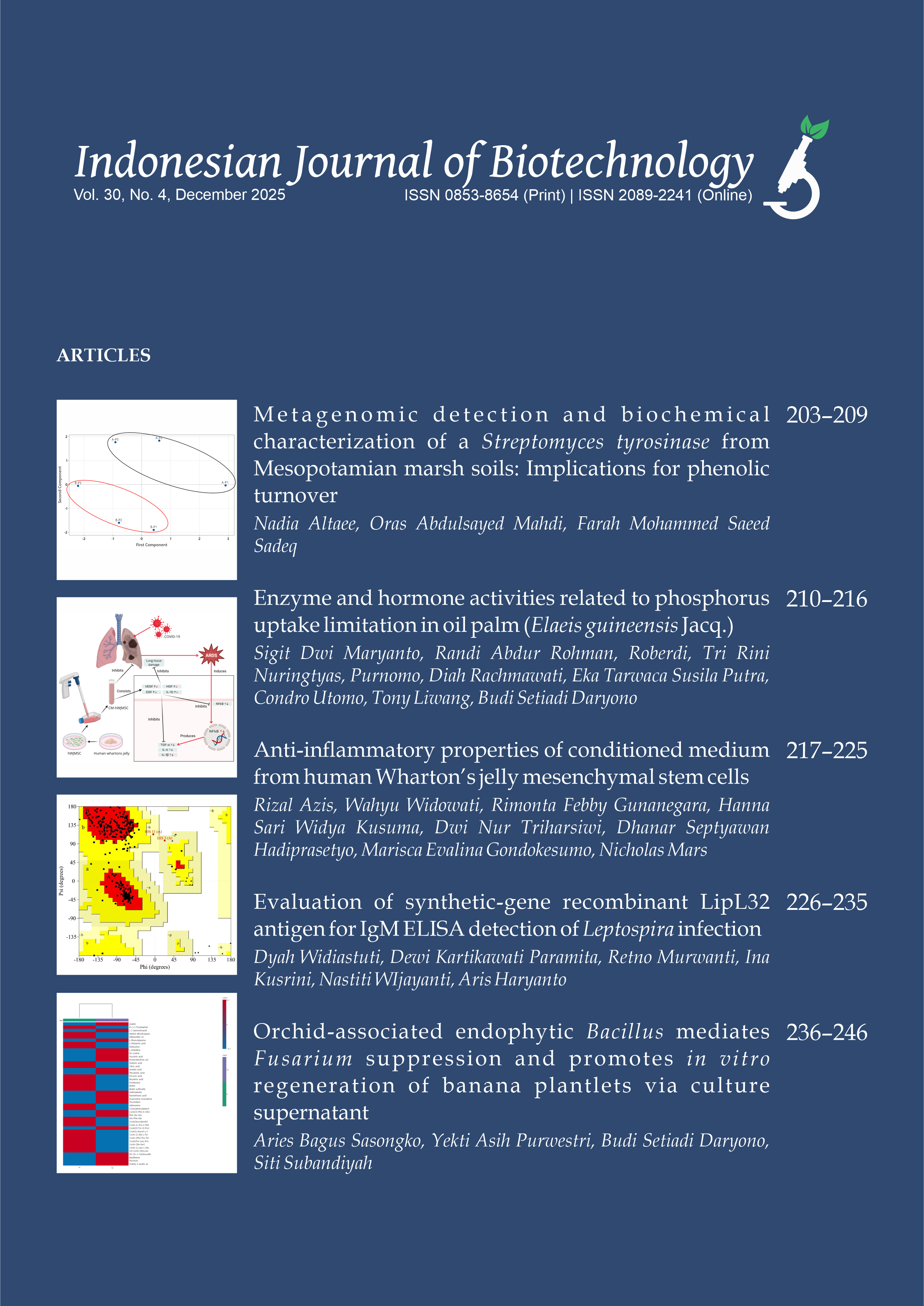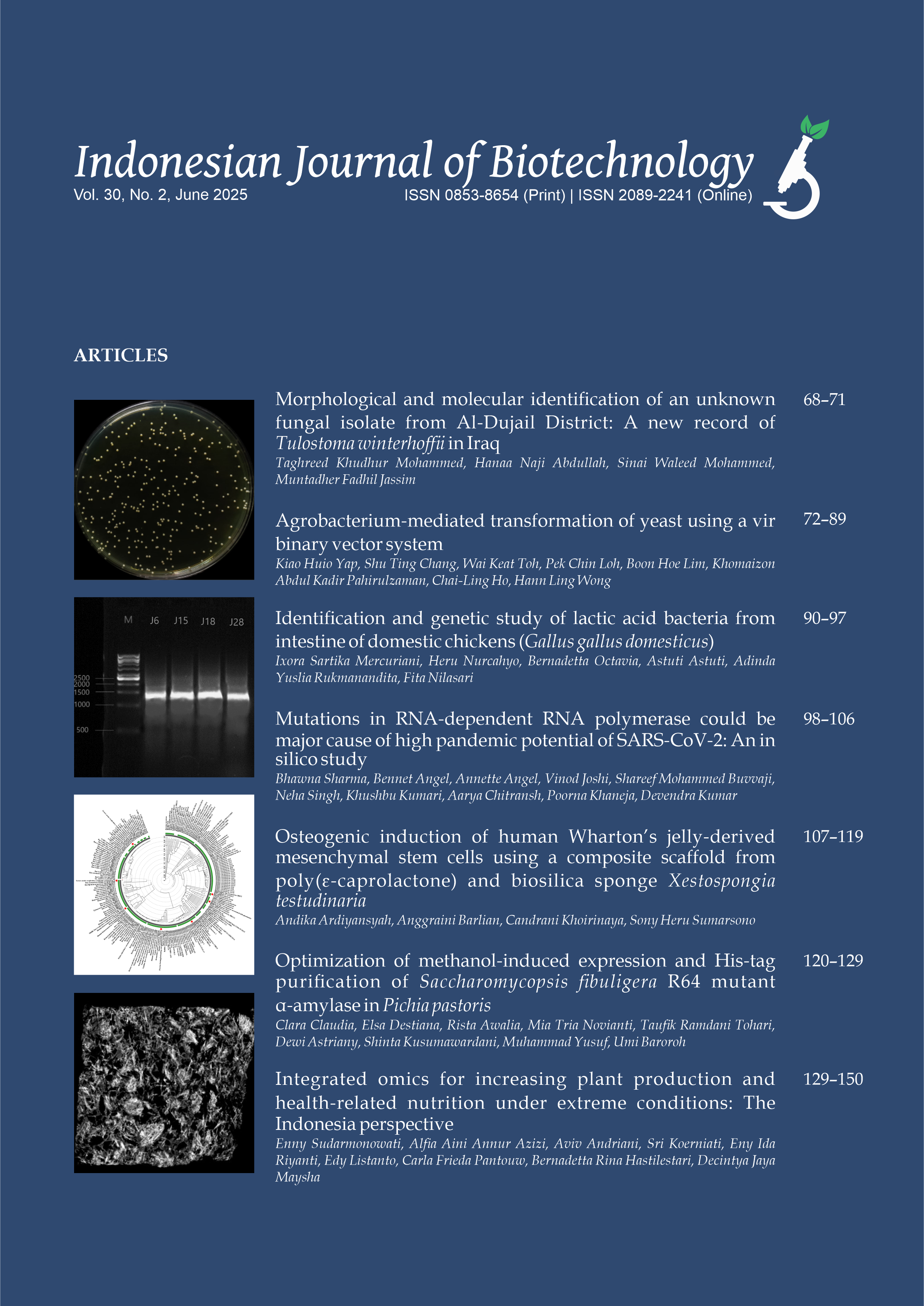Biofilm formation analysis and molecular identification of copper-resistant bacteria isolated from PT Freeport Indonesia’s tailings
Maria Massora(1*), Erni Martani(2), Eko Sugiharto(3), Roberth Sarwom(4), Tumpal Sinaga(5)
(1) Doctoral Student of Biotechnology Study Program, Graduate School of Universitas Gadjah Mada, Jl. Teknika Utara, Yogyakarta, 55281, Indonesia
(2) Department of Microbiology, Faculty of Agriculture, Universitas Gadjah Mada, Jalan Flora, Yogyakarta, 55281, Indonesia
(3) Department of Chemistry, Faculty of Mathematics and Science, Universitas Gadjah Mada, Jalan Sekip Utara, Yogyakarta, 55281, Indonesia
(4) Environmental Department, PT Freeport Indonesia, Jalan Mandala Raya No. 1 OB-2, Timika 99920, Indonesia
(5) Environmental Department, PT Freeport Indonesia, Jalan Mandala Raya No. 1 OB-2, Timika 99920, Indonesia
(*) Corresponding Author
Abstract
Copper is an essential macronutrient for living organisms. Nevertheless, at high concentrations, it is toxic to most forms of life, including microorganisms. In this research, we examined the biofilm formation ability and identified the molecular characteristics of copper-resistant bacteria isolated from PT Freeport Indonesia’s tailings. Four bacteria isolates from PT Freeport Indonesia’s tailings were used in this study. Qualitative analysis of biofilm formation by copper-resistant bacteria was performed using the Scanning Electron Microscopy (SEM) method and Microtiter Plate Biofilm Assay. The results showed that the C53 isolate could be categorized as a strong biofilm former, and three other isolates (C38, C40, and C43) as medium biofilm formers. The identity of the selected isolates was based on 16S rRNA gene sequence analysis: C38 isolate had a 99% similarity to Bacillus cereus strain HM85, C43 isolate had a 99% similarity to Bacillus subtilis strain EN16, C40 isolate had a 99% similarity to Lycinibacillus fusiformis strain MB52, and C53 isolate had a 98% similarity to Pseudomonas aeuruginosa strain GGRJ21. The capability of the C53 isolate to form strong biofilm can be exploited in bioremediation processes aiming to remove copper from tailings.
Keywords
Full Text:
PDFReferences
Alipour M, Suntres ZE, Omri A. 2009. Importance of DNase and alginate lyase for enhancing free and liposome encapsulated aminoglycoside activity against Pseudomonas aeruginosa. Journal of Antimicrobial Chemotherapy 64:317–325. doi:10.1093/jac/dkp165.
Andersson S, Nilsson M, Dalhammar G, Kuttuva Rajarao G. 2008. Assessment of carrier materials for biofilm formation and denitrification. Vatten 64:201–207.
Andreazza R, Pieniz S, Okeke B., Camargo FA. 2011. Evaluation of copper resistant bacteria from vineyard soils and mining waste for copper biosorption. Brazilian Journal of Microbiology 42:66–74. doi:10.1590/S1517-83822011000100009.
Annous BA, Fratamico PM, Smith JL. 2009. Scientific Status Summary. Journal of Food Science 74:R24–R37. doi:10.1111/j.1750-3841.2008.01022.x.
Cerca N, Pier GB, Vilanova M, Oliveira R, Azeredo J. 2005. Quantitative analysis of adhesion and biofilm formation on hydrophilic and hydrophobic surfaces of clinical isolates of Staphylococcus epidermidis. Res. Microbiol. 156:506–514. doi:10.1016/j.resmic.2005.01.007.
Chen Y-Q, Ren G-J, An S-Q, Sun Q-Y, Liu C-H, Shuang J-L. 2008. Changes of Bacterial Community Structure in Copper Mine Tailings After Colonization of Reed (Phragmites communis). Pedosphere 18:731–740. doi:10.1016/S1002-0160(08)60068-5.
Desai C, Jain K, Madamwar D. 2008. Evaluation of in vitro Cr(VI) reduction potential in cytosolic extracts of three indigenous Bacillus sp. isolated from Cr(VI) polluted industrial landfill. Bioresour. Technol. 99:6059–6069. doi:10.1016/j.biortech.2007.12.046.
Freitas O, Delerue-Matos C, Boaventura R. 2009. Optimization of Cu(II) biosorption onto Ascophyllum nodosum by factorial design methodology. Journal of Hazardous Materials 167:449–454. doi:10.1016/j.jhazmat.2009.01.001.
He Z, Gao F, Sha T, Hu Y, He C. 2009. Isolation and characterization of a Cr(VI)-reduction Ochrobactrum sp. strain CSCr-3 from chromium landfill. J. Hazard. Mater. 163:869–873. doi:10.1016/j.jhazmat.2008.07.041.
Khusnuryani A, Martani E, Wibawa T, Widada J. 2016. Molecular Identification of Phenol-Degrading and Biofi lm-Forming Bacteria from Wastewater and Peat Soil. Indonesian Journal of Biotechnology 19:99-. doi:10.22146/ijbiotech.9299.
Mathur T, Singhal S, Khan S, Upadhyay DJ, Fatma T, Rattan A. 2006. Detection of biofilm formation among the clinical isolates of Staphylococci: an evaluation of three different screening methods. Indian J Med Microbiol 24:25–29.
Méndez-Vilas A. 2013. Microbial Pathogens and Strategies for Combating Them: Science, Technology and Education. Formatex Research Center.
Monier J-M, Lindow SE. 2003. Differential survival of solitary and aggregated bacterial cells promotes aggregate formation on leaf surfaces. Proc Natl Acad Sci U S A 100:15977–15982. doi:10.1073/pnas.2436560100.
Moretro T, Hermansen L, Holck AL, Sidhu MS, Rudi K, Langsrud S. 2003. Biofilm Formation and the Presence of the Intercellular Adhesion Locus ica among Staphylococci from Food and Food Processing Environments. Applied and Environmental Microbiology 69:5648–5655. doi:10.1128/AEM.69.9.5648-5655.2003.
Rademacher C, Masepohl B. 2012. Copper-responsive gene regulation in bacteria. Microbiology 158:2451–2464. doi:10.1099/mic.0.058487-0.
Ratnayake K, Joyce DC, Webb RI. 2012. A convenient sample preparation protocol for scanning electron microscope examination of xylem-occluding bacterial biofilm on cut flowers and foliage. Scientia Horticulturae 140:12–18. doi:10.1016/j.scienta.2012.03.012.
Santo CE, German N, Elguindi J, Grass G, Rensing C. 2014. Biocidal Mechanisms of Metallic Copper Surfaces. In: Use of Biocidal Surfaces for Reduction of Healthcare Acquired Infections. Springer, Cham. p. 103–136.
Smaldone GT, Helmann JD. 2007. CsoR regulates the copper efflux operon copZA in Bacillus subtilis. Microbiology (Reading, Engl.) 153:4123–4128. doi:10.1099/mic.0.2007/011742-0.
de Souza EL, Meira QGS, de Medeiros Barbosa I, Athayde AJAA, da Conceição ML, de Siqueira Júnior JP. 2014. Biofilm formation by Staphylococcus aureus from food contact surfaces in a meat-based broth and sensitivity to sanitizers. Braz J Microbiol 45:67–75.
Tamura K, Stecher G, Peterson D, Filipski A, Kumar S. 2013. MEGA6: Molecular Evolutionary Genetics Analysis version 6.0. Mol. Biol. Evol. 30:2725–2729. doi:10.1093/molbev/mst197.
Tang PL, Pui CF, Wong WC, Noorlis A, Son R. 2012. Biofilm forming ability and time course study of growth of Salmonella Typhi on fresh produce surfaces. International Food Research Journal 19.
Teitzel GM, Geddie A, De Long SK, Kirisits MJ, Whiteley M, Parsek MR. 2006. Survival and Growth in the Presence of Elevated Copper: Transcriptional Profiling of Copper-Stressed Pseudomonas aeruginosa. Journal of Bacteriology 188:7242–7256. doi:10.1128/JB.00837-06.
Thaden JT, Lory S, Gardner TS. 2010. Quorum-Sensing Regulation of a Copper Toxicity System in Pseudomonas aeruginosa. J Bacteriol 192:2557–2568. doi:10.1128/JB.01528-09.
Umrania VV. 2006. Bioremediation of toxic heavy metals using acidothermophilic autotrophes. Bioresource Technology 97:1237–1242. doi:10.1016/j.biortech.2005.04.048.
Van Houdt R, Michiels CW. 2010. Biofilm formation and the food industry, a focus on the bacterial outer surface. J. Appl. Microbiol. 109:1117–1131. doi:10.1111/j.1365-2672.2010.04756.x.
Workentine ML, Harrison JJ, Stenroos PU, Ceri H, Turner RJ. 2008. Pseudomonas fluorescens’ view of the periodic table. Environ. Microbiol. 10:238–250. doi:10.1111/j.1462-2920.2007.01448.x.
Article Metrics
Refbacks
- There are currently no refbacks.
Copyright (c) 2017 The Author(s)

This work is licensed under a Creative Commons Attribution-ShareAlike 4.0 International License.









